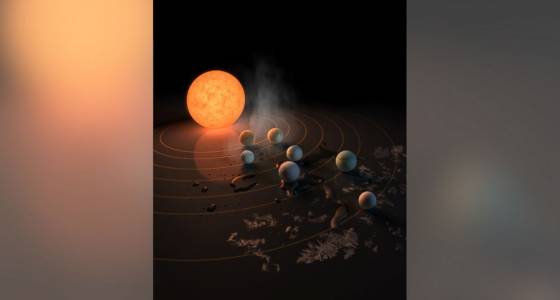An international group of astronomers has discovered seven potentially habitable exoplanets — or planets outdoors our solar program — that could have liquid surface water, according to a paper published now in the journal Nature.
"The discovery gives us a hint that obtaining a second Earth is not just a matter of if but when," Thomas Kutcher, an associate administrator of the science mission directorate at NASA headquarters in Washington, mentioned at a news conference currently.
It is a big step forward, he said, in answering the age-old question "Are we alone out there?"
Although it is unclear regardless of whether any of the seven exoplanets can harbor life, astronomers mentioned they all could have liquid water — the important to life as we know it.
The not too long ago discovered planets have been nicknamed Earth's seven sisters and have masses and rocky compositions related to our planet's, scientists said.
3 of the seven planets are deemed to be in the habitable zone, or the location about a star exactly where a rocky planet is most likely to have liquid water, researchers added.
Astronomers pointed out that the seven planets orbit TRAPPIST-1, a dwarf star that is much younger than our sun and ought to burn for an additional 10 trillion years — much more than 700 occasions longer than the universe is believed to have been in existence. That is "arguably enough time for life to evolve," an short article in Nature reported.
TRAPPIST-1, named following the Transiting Planets and Planetesimals Compact Telescope project, is about 39 light-years, or 235 trillion miles, from Earth. It is in the constellation Aquarius.
Astronomers noted that they are awaiting the scheduled launch of NASA's James Webb Space Telescope in 2018 to determine the exoplanets' situations, such as atmospheric composition and climate. That telescope is expected to be considerably more effective than the Hubble Space Telescope.
The James Webb Space Telescope can detect molecules like water, methane, ozone and oxygen — which can then support scientists identify a planet's habitability and possibilities of harboring life, according to Nikole Lewis, an astronomer at the Space Telescope Science Institute in Baltimore.
The discovery of the planetary system suggests that Earth-size planets are a lot a lot more abundant and common in the Milky Way galaxy than previously believed, researchers stated.
"With this amazing program, we know there ought to be many a lot more potentially life-bearing worlds out there waiting to be found," mentioned Sara Seager, a professor of planetary science and physics at the Massachusetts Institute of Technologies.
The astronomers who discovered the exoplanets stated they will be ramping up their efforts to locate and recognize other planets about tiny stars in the vicinity of our sun through the Search for Habitable Planets Eclipsing Ultra-Cool Stars (SPECULOOS) project.
Moreover, NASA mentioned it plans to launch the Transiting Exoplanet Survey Satellite (TESS), a space telescope that will commit two years browsing for planets in orbit around much more than 200,000 of the brightest stars in the sky.
"The seven wonders of TRAPPIST-1 are the first Earth-size planets that have been found orbiting this kind of star," mentioned Michael Gillon, the lead author of the paper published in Nature and the principal investigator of the TRAPPIST exoplanet survey at the University of Liege in Belgium.
He added at the NASA news conference currently that the discovery of the TRAPPIST-1 planetary technique is a very promising indicator for the search for life beyond Earth.
Our editors found this article on this site using Google and regenerated it for our readers.












